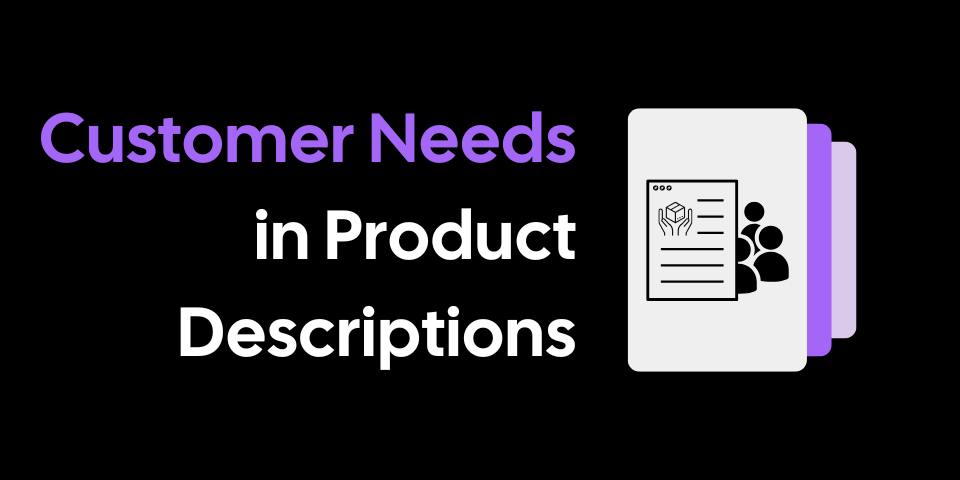
Why Addressing Customer Needs in Product Descriptions is Relevant
Product descriptions are often overlooked, but their impact on purchasing decisions is undeniable. A description that resonates with customer priorities can turn indecision into action. This article provides a straightforward framework for crafting product descriptions that address real needs and drive conversions.
Addressing Customer Needs
A product description should do more than describe—it should solve. Customers seek solutions that align with their expectations and values, not just a list of features. By focusing on customer needs, a description can evolve into a persuasive sales tool that builds trust and motivates action.
Crafting effective descriptions starts with understanding the core issues your customers face. It requires insight into their frustrations, preferences, and priorities, turning vague needs into actionable copy. This guide will show how to align product messaging with customer psychology to create descriptions that feel logical, relevant, and impactful.
Decoding Customer Psychology
Purchases are driven by a mix of practical needs and emotional factors. When customers describe a product as “reliable” or “easy to use,” these terms reflect deeper motivations, such as saving time or avoiding frustration. Understanding these drivers lets you write descriptions that resonate.
- Ease of Use: A customer looking for simplicity might value this phrasing: “Setup in minutes, so you can get started right away.”
- Durability: Buyers seeking reliability need assurance: “Built to withstand everyday wear and tear.”
Decoding this hidden language requires reviewing customer feedback and identifying recurring themes. Use this data to frame your descriptions around what customers care about most. Strategies for trustworthy content can further help create descriptions that align with these insights.
Turning Personas into Conversations
To connect with your audience, speak their language. Descriptions tailored to specific customer personas stand out because they feel personal and relevant.
[Example]
- For busy parents: “Folds with one hand for easy storage while you hold your little one.”
- For entrepreneurs: “Keep everything organized and accessible so you can focus on growing your business.”
Creating persona-driven content requires detailed research into audience preferences. By aligning language with their perspectives, you position your product as the obvious choice. For more on creating personalized content, explore these tailored strategies.
Selling Outcomes, Not Features
Customers care less about features and more about how a product impacts their lives. Shifting your focus from “what it does” to “what it solves” transforms your descriptions into powerful messaging.
[Example]
- Feature-focused: “Includes heart rate monitoring.”
- Outcome-focused: “Monitor your progress and recover smarter to hit your fitness goals.”
Ask yourself:
- What problem does this feature solve?
- How does it improve the customer’s experience?
Descriptions framed around outcomes emphasize the product’s value. For more on creating emotionally resonant copy, explore how authenticity builds trust.
Tactical Post as Your Assistant
Writing impactful descriptions can be challenging, but the right tools make it manageable. Tactical Post simplifies the process with features designed to streamline your workflow.
At its core, this mirrors the backend logic of Tactical Post, which uses a similar structured approach to streamline the process for clients. By easing the burden of research and providing clear, well-organized instructions, it allows businesses to focus on what matters—connecting with their audience while it does the heavy lifting.
With this tool you can craft descriptions that reflect customer needs while saving time.
Strategies That Work
Voice of Customer (VoC)
Customer feedback is a goldmine for impactful language. Reviews and surveys reveal the exact terms your audience uses to describe their needs. Incorporating these phrases creates relatability and trust.
Example: If customers say, “This saved me time,” use: “Designed to save you time, so you can focus on what matters most.”
Comparisons Without Gimmicks
When positioning your product against competitors, subtlety is key. Avoid exaggerated claims that can undermine credibility. Instead, focus on strengths that matter.
Example: “Unlike traditional options, this product streamlines X without the drawbacks of Y.”
Transparency for Pain Points
Acknowledging what your product doesn’t do can build trust. Customers value honesty, especially when it aligns with their expectations.
Example: “Focused on essential features—no unnecessary extras or hidden fees.”
A Methodology for Customer-Centric Descriptions
Writing great descriptions is a process:
01
Gather customer insights through reviews and feedback
02
Highlight outcomes rather than features to showcase value
03
Use performance data to continuously improve your approach
Example: Instead of “advanced noise-canceling technology,” try: “Eliminate distractions with immersive sound, whether at work or on the go.”
Conclusion
Effective product descriptions bridge the gap between features and customer needs. By focusing on outcomes, personalizing language, and using insights from your audience, you can turn product pages into conversion tools.
With tools like Tactical Postand strategies grounded in customer understanding, you can create descriptions that are clear, impactful, and tailored to drive results.